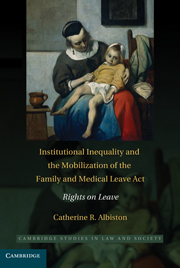Book contents
- Frontmatter
- Contents
- Preface
- Acknowledgments
- 1 Institutions, Inequality, and the Mobilization of Rights
- 2 The Social Institution of Work
- 3 Institutional Inequality and Legal Reform
- 4 Mobilizing the FMLA in the Workplace: Rights, Institutions, and Social Meaning
- 5 Mobilizing Rights in the Courts: The Paradox of Losing by Winning
- Conclusion
- Appendix A
- Appendix B
- References
- Index
- Cambridge Cultural Social Studies
Preface
Published online by Cambridge University Press: 05 October 2010
- Frontmatter
- Contents
- Preface
- Acknowledgments
- 1 Institutions, Inequality, and the Mobilization of Rights
- 2 The Social Institution of Work
- 3 Institutional Inequality and Legal Reform
- 4 Mobilizing the FMLA in the Workplace: Rights, Institutions, and Social Meaning
- 5 Mobilizing Rights in the Courts: The Paradox of Losing by Winning
- Conclusion
- Appendix A
- Appendix B
- References
- Index
- Cambridge Cultural Social Studies
Summary
For many years the United States was virtually the only major industrialized country without a family and medical leave policy. Employers could legally fire a worker who needed time off to care for a seriously ill child, parent, or spouse. Employers had wide latitude to fire workers temporarily unable to work because of illnesses or injuries. Employers could legally fire women who needed time off for pregnancy and childbirth if they also denied time off to nonpregnant employees who were unable to work. And, although some employers provided parental leave after the birth of a new child, this discretionary leave was primarily available to professional or management employees and not to the rank and file (Kamerman et al. 1983). In short, national employment policy left many serious family and medical needs unaddressed.
By the end of the twentieth century, significant social changes made difficult choices about managing work, family, and illness more visible and compelling. Stagnating wages and changing gender roles meant more women with children entered the workforce, contributing to a time squeeze for many families (Epstein & Kalleberg 2004; Gornick & Meyers 2003; Jacobs & Gerson 2004; Presser 2003). Increasing divorce rates also left many working women as the sole source of support for their families (Reskin & Padavic 1994). As medical care improved and legal reforms required education for children with disabilities, there were more potential workers with disabilities (Shapiro 1993).
- Type
- Chapter
- Information
- Institutional Inequality and the Mobilization of the Family and Medical Leave ActRights on Leave, pp. vii - xivPublisher: Cambridge University PressPrint publication year: 2010

